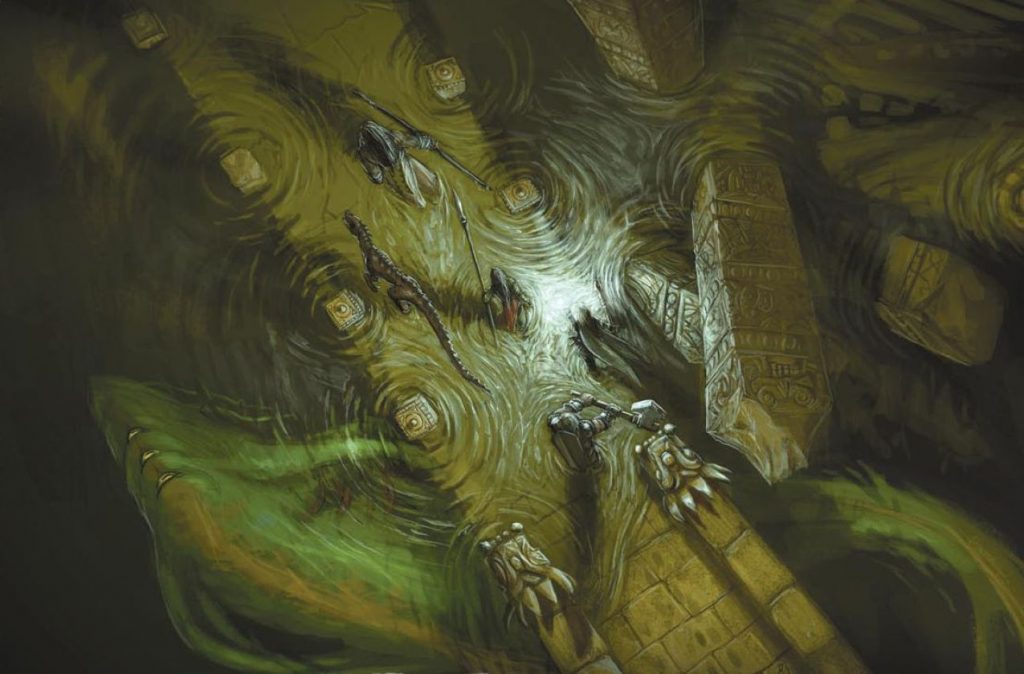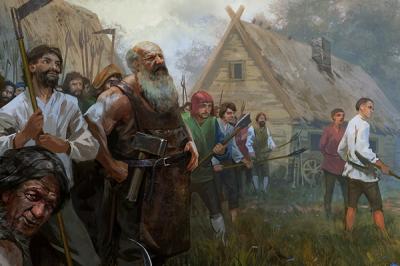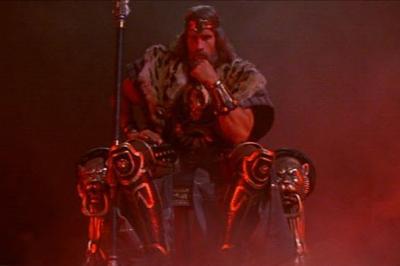I retroactively added this post to the WCotFP series and made some small channges accordingly.
Encumbrance is possibly the most hated and most ignored rule in games like Dungeons & Dragons, simply because it’s way too much bookkeeping for usually no noticable gain. An Encumbrance system that people are actually going to use has to be so simple that it’s practically invisible when not doing anything, but immediately available when it becomes relevant. As a GM you never want to tell the players “please look up the weights for all the items in your inventory and calculate your modified travel speed because of Encumbrance”. You just wouldn’t do that.
Why have Encumbrance in the first place?
Because Encumbrance shows up so rarely in adventures and campaigns and the games work just fine without it, there’s the obvious question why to bother with it at all? The answer I have to that is that the effects of Encumbrance are actually a lot of fun and can lead to great encounters and even whole adventures. It all comes down to the players having to make decisions what things they want to carry with them and what things to leave behind. The more stuff you carry, the slower you move. In the older editions of Dungeons & Dragons this is hugely important. Characters get some experience points for defeating monsters and other enemies, but the majority of XP will be gained from bringing treasures back from their adventures. The most efficient way to become more powerful and not dying in the process is to steal treasure without fighting the onwer. And if you do get caught, it’s often the smartest way to run. The amount of experience you get depends on how much treasure you collect. The speed at which you run depends on how much tools and treasure you are carrying. This is a kind of conflict, and both in fiction and RPGs, conflicts are always great. That’s where things get interesting.
There are also the wandering monsters and random encounters. The longer you stay in a dungeon, the greater the chance of accidentally running into someone. Since wandering monsters generally don’t carry their treasure with them, they are a lot of danger for very little potential reward. The best way to get treasure out of a dungeon is to do it quick, and to be quick you need to be able to move fast. Do you really need that big bag of copper coins that are worth barely any XP? Would it perhaps be better to just ditch it? How much are you willing to risk for a few XP more?
When dealing with wilderness adventures where the characters are away from civilization for days and weeks, another element comes into play. Without places to simply buy food, you have to bring your own or be able to find some along the way. If you run out, you have a problem. This is especially important when traveling through deserts, where you might have to carry a great amount of supplies, which will slow you down a lot and make the whole trip significantly longer. And staying longer in the desert means greater risk of running into someone hostile. And, as players of post-apocalyptic campaigns might probably know, it makes supplies a potentially valuable type of treasure to be found. Unfortunately, most RPGs don’t bother with any rules for going without food and water and so this is something that almost never comes up. Tankfully, Lamentations of the Flame Princess does have some pretty decent rules to cover thirst and hunger in easy to handle ways and also with a simple system to find new supplies in the wilderness. I recommend using those.
Tracking Encumbrance the easy way
When it comes to a system for determine a character’s Encumbrance level, I simply recommend using the system from Pencil and Paper. This is by far the best way to track Encumbrance I have ever seen and even though it was designed with Pathfinder in mind it works with every game that has a Strength score and movement speeds. LotFP uses something that is based on the same idea, but I think this execution is even much more elegant than that.
The rules I am using for the Ancient Lands are these:
- All items smaller and lighter than a dagger do not count towards encumbrance. Containers holding multiple such insignificant items (like a bag of coins, a quiver of arrows, and so on) count as a single item.
- Items that require both hands to carry or are unusually large (such as a polearm) count as two items.
- Light armor counts as two item, medium armor counts as four items, and heavy armor counts as six items.
- Characters carrying a number of items no greater than their Strength score are unencumbered and have a speed of 120′ per round/24 miles per day.
- Characters carrying a number of items no higher than two times their Strength score are lightly encumbered and have a speed of 90′ per round/18 miles per day. If attempting to swim, they have a 1 in 6 chance of drowning.
- Characters carrying a number of items no higher than three times their Strength score are heavily encumbered and have a speed of 60′ per round/12 miles per day. If attempting to swim, they have a 3 in 6 chance of drowning.
As by the standard rules of LotFP, being encumbered has some limitations on the use of skills. Characters other than specialists can not make dificult climbs requiring Climb checks if they are encumbered. Specialists (and scouts) have their Climb and Stealth skills reduced by 1 in 6 when lightly encumbered and by 2 in 6 if heavily encumbered.
Tracking Encumbrance
But don’t you still have to constantly count the numbers of items in your inventory and then check the Encumbrance table? With the right type of inventory sheet, you don’t. Most character sheets have a space for the inventory that just consists of a number of rows. Simply number each row at the left and then make sure you won’t have any empty spaces when you fill in your items that you are carrying. The number of the last row that holds and item is the number of items you carry. Since the amount of items you can carry never changes as the character advances, you can then simply use some kind of marker to make a clear line below row 10, row 20, and row 30 if your character has a Strength of 10.
To the left of the list you can then simply make a small note for the movement speed your character has when the inventory is filled up to those marked lines. You will always be able to tell immediately what your current movement speed is whenever the GM wants to know it, and it doesn’t mean any extra work for the players. All they have to do is write all their items down on the inventory sheet.
Encumbrance for mounts and pack animals
One thing that RPGs (and fantasy in general) almost always gets wrong is how traveling with a horse works. On a short sprint, a horse will always beat a human easily. But when it comes to endurance running, the only creature on Earth that can keep up with humans are dogs. This is the big superpower of our two species and was the beginning of a wonderful fiendship (consisting mostly of killing other animals and eating them). All other animals need a lot of rest during the day and can’t keep marching all day. For humans and horses, the differences between speed and endurance are about canceling each other out and so you are not going to be any faster on a horse than on foot. That is, if you are not carrying any big loads.
If you have to not just get yourself from one point to another, but also a lot of other stuff, a horse can make a big difference, especially when you’re not riding it. Having a horse allows you to walk without having to carry anything, while your horse is slowed down only very little by what would be a really heavy load for yourself. And if you have two horses you can ride one while the other carries your stuff, and so you don’t have to walk.
So the effects of encumbrance for mounts are like this:
- Small characters count as 10 items, human sized characters count as 30 items, and large characters count as 50 items for calculating encumbrance. All the items carried by characters have to be added to be mount’s encumbrance as well.
- Mounts carrying a number of items no greater than their Strength score are unencumbered and have a speed of 240′ per round/24 miles per day.
- Mounts carrying a number of items no higher than two times their Strength score are lightly encumbered and have a speed of 180′ per round/18 miles per day.
- Mounts carrying a number of items no higher than three times their Strength score are heavily encumbered and have a speed of 120′ per round/12 miles per day.
I originally had another post covering water and Rations, but I since realized that this system doesn’t really work, so better ignore it



